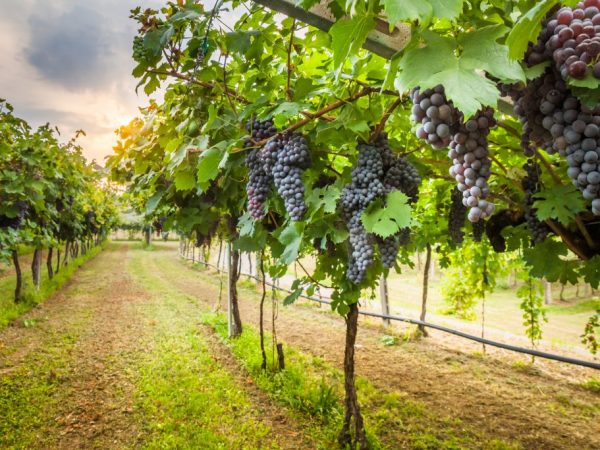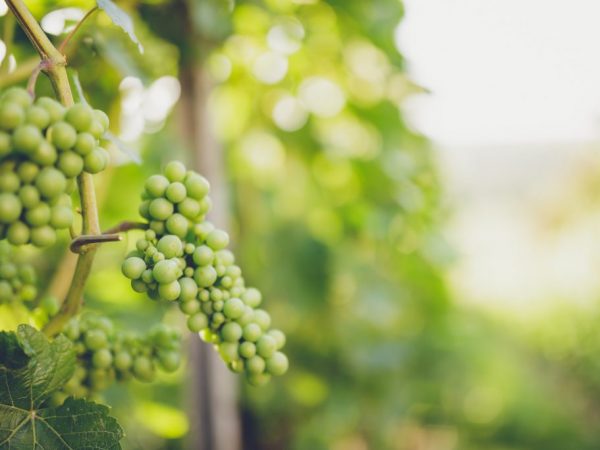Growing grapes outdoors
The cultivation of a grape crop has many characteristics. Planting grapes in the open field, as well as further care, must be correct, because the growth of the planted bushes, their health and yield depend on this.

Growing grapes outdoors
Saplings for planting
Having decided to purchase seedlings in specialized nurseries, it is important to take into account the varietal characteristics of the culture, as well as the state of the planting material. The rooted material should not look sluggish or dry. The foliage should be green, and the roots should be free from signs of damage.
It is worth paying attention to the grafted seedlings, especially if you plan to plant them in a temperate or northern climate. Most of this planting material is highly resistant to frost, as well as to diseases and pests.
Harvesting of seedlings
Both rooted cuttings and layering are used as planting material. Among all propagation methods, the most common is cuttings. Planting material has been prepared since autumn:
- Vines with a diameter of 5-10 mm are cut into small pieces. Each of them should have 5-7 eyes.
- Cut cuttings are treated with a 1% solution of copper sulfate, soaked in water for 2 days.
- The cuttings are dried and placed in a plastic bag. Store until spring in a cool place with high air humidity.
Preparation for growing crops begins from the first days of spring. Cuttings are taken out of the bag and soaked in water until roots appear. It is also effective to use a rooting stimulant.
Planting grapes
The basis for growing grapes is soil. Before planting harvested seedlings, the grower should focus on its composition and quality. If clay soils prevail on the site, the bushes are planted in trenches, if sandy - in rows.
Another nuance is the landing site. The seedlings are planted in a sunny location well protected from drafts. The best place is near the wall of a house or other structure. It is effective to plant grapes in the south or southwest of such barriers. It is not necessary to plant a crop in the lowlands: such a place is often located close to groundwater.
Boarding time
It is better to plant seedlings in spring, when the soil has time to warm up to 6 ° C-8 ° C. Most often this period coincides with the beginning of sap flow. Planting material obtained by cuttings is planted later, when warm weather sets in the street without the threat of spring frosts.
Autumn planting is suitable only for the southern regions with their characteristic mild climate. It is better to plant a crop in October or early November. It is important to cover annual seedlings in order to avoid the harmful effects of cold weather.
Disembarkation procedure
Planting seedlings in the soil depends on the type of soil.
In fertile soils, fertile litter (black soil with humus) is laid on the bottom of the pit. Its layer is 25 cm. In sandy soils, a layer of clay is also needed.The pit itself should be 80 cm deep and wide.
The seedling is planted on the soil treated with mineral fertilizers. The best option for feeding is a mixture of potash fertilizers (300 g), superphosphate (300 g) and 3 liters of wood ash. A layer of fertilizer with soil (5 cm) is spread on top of the nutrient litter. Then the landing itself is performed:
- A small embankment is organized at the bottom of the prepared pit.
- A seedling is placed in the center of the embankment, carefully spreading the roots.
- Sprinkle the seedling with soil to the point of growth.
After planting, the soil is tamped and watered. 20 liters of water are added under the bush. After drying, the top layer of the soil is loosened.
Grape care

The plant needs regular watering
The cultivation of the planted culture is based on the use of a complex of agrotechnical measures. Caring for grapes includes proper organization of watering, feeding, tying and pruning.
With the beginning of the growing season, the watering season opens. In the first year of growing crops, you will have to pour 20 liters of water under each bush. In total, 5-8 such procedures are carried out per season. Features of other cultural care activities:
- Garter. Until 1-2 years after planting, the plant is supported by a support dug in next to the seedling. As the bush grows, an arch or trellis is installed, tying the vine to a horizontally stretched wire. The shoot is in a horizontal position. Garter material - fabric or textile cord.
- Top dressing. With the beginning of the growing season, nitrogen fertilizers are applied, with the beginning of flowering - superphosphate (30 g), ammonium sulfate (20 g) and potassium salt (10 g). When the plant is ready to bear fruit, the introduction of formulations with phosphorus and potassium is required.
- Pruning. It is carried out for 2-3 years after planting in open ground. The first is to organize the pruning of an annual vine along internodes, and when creating a sleeve, a short (2-3 eyes), long (6-8 buds are left) and mixed (for a fruit link) are carried out.
An important procedure when growing grape crops in the open field is pinching a fruitful shoot. The need for this care measure is caused by the distribution of the forces of the bush in favor of the formation of inflorescences. It is carried out before flowering.
The need for shelter for the winter
Depending on the selected grape variety, as well as on the characteristics of the climatic conditions, the procedure for sheltering the plant for the winter is useful. Its purpose is to protect the roots, shoots and dormant buds of the culture from the harmful effects of severe frosts.
Some vineyard owners recommend covering all grape varieties in the first 2-3 years after planting to avoid damage to the bushes. Having untied the shoots from the trellis and having previously spread spruce branches on the ground, the branches are wrapped with spandbond or lutrasil. The folded sleeves are covered with oilcloth on top to create a greenhouse effect. The shelter is removed only in the spring, when stable weather is established on the street without the risk of frost.
Prevention of diseases and pests
Vineyards often suffer from infection with fungal and viral diseases, and are damaged by pests.
The greatest danger to culture is represented by mildew, oidium, black and gray rot. The prevention of such diseases is based on the spring and autumn treatment of bushes and the periosteal circle with a 3% solution of copper sulfate. If infection cannot be avoided, systemic fungicides are used.
Among pests, leaf rollers, scale insects and phylloxera are the main threat to grapes. It will be possible to avoid the attack of such pests with the spring spraying with insecticides "Fufanon-Nova", "Inta-Vir", "Alatar", etc.
Conclusion
For planting in open ground, both young seedlings grown in pots and root shoots are used. When quality conditions are created, the plant takes root quickly, and after a few years it gives the first harvest.

